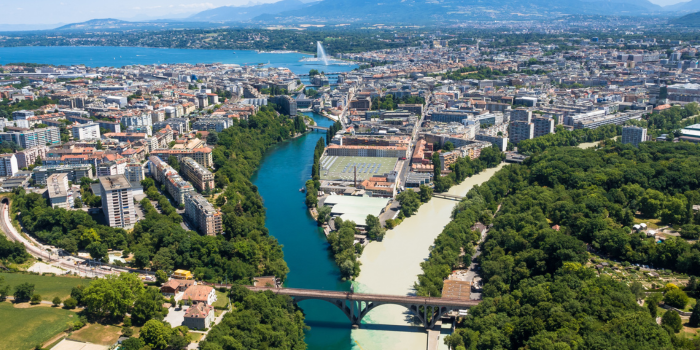Imagine living in a city where you can breathe fresh air, enjoy green spaces, use renewable energy, and access public transportation easily. A city where you can reduce your environmental footprint, save money, and improve your health and well-being. A city where you can be part of a community that cares about sustainability and the future of the planet.
Sounds too good to be true, right? Well, not quite. There are actually many cities around the world that are striving to become more sustainable and green, and some of them are doing a pretty good job at it.
But which ones are the greenest of them all? How do they compare with each other in terms of environmental performance and quality of life? And what can we learn from them to make our own cities more eco-friendly?
To answer these questions, we have compiled our own list of the top 20 greenest cities in the world, based on various online resources and rankings. We have used the following criteria to determine our scores:
- The percentage of public green spaces, such as parks, gardens, and forests.
- The percentage of renewable energy sources, such as solar, wind, and hydropower.
- The percentage of public transportation users, such as buses, trains, and bikes.
- The level of air pollution, measured by the concentration of particulate matter (PM2.5) and nitrogen dioxide (NO2).
- The per capita water consumption, measured by the amount of water used per person per day.
- The walkability of a city, measured by the ease and safety of walking. It assesses how convenient and secure it is to navigate by foot within the urban environment.
- The availability of city-wide recycling and composting programs, measured by the percentage of waste diverted from landfills.
- The availability of farmer’s markets and organic food options, measured by the number and frequency of such venues.
- The level of environmental awareness and education, measured by the number and quality of green initiatives and campaigns.
We have assigned a score from 1 to 10 for each criterion, based on the data and information available from various sources. Then we have calculated the average score for each city to rank them from highest to lowest. Of course, this is not a perfect or definitive ranking, as different sources may have different methodologies and data quality. However, we have tried to be as objective and consistent as possible, and to provide references for our sources.
So without further ado, here are our top 20 greenest cities in the world:
1. Copenhagen, Denmark
Score: 9.1/10
Copenhagen is widely regarded as one of the world’s greenest cities and for good reasons. The Danish capital has ambitious goals to become carbon neutral by 2025, and to be the world’s first zero-waste city by 2050. To achieve these goals, Copenhagen has invested heavily in renewable energy, public transportation, cycling infrastructure, green buildings, waste management, and urban planning.
Some of the highlights of Copenhagen’s green achievements include:
- More than 50% of its electricity comes from wind power.
- More than 75% of its population uses public transportation or bikes to commute.
- More than 60% of its hotel rooms are certified as eco-friendly.
- More than 90% of its organic waste is recycled or composted.
- More than 400 km of bike lanes crisscross the city.
- More than 8% of its land area is covered by parks and gardens.
Copenhagen is also a vibrant and livable city, with a high quality of life, a rich cultural heritage, a diverse gastronomy scene, and a friendly and welcoming atmosphere. It is no wonder that Copenhagen is often ranked as one of the happiest cities in the world.
2. Stockholm, Sweden
Score: 8.9/10
Stockholm is another Nordic city that excels in sustainability and green living. The Swedish capital was the first city to receive the European Green Capital Award in 2010, and has since continued to improve its environmental performance and innovation. Stockholm aims to be fossil fuel free by 2040, and to reduce its greenhouse gas emissions by 80% by 2030.
Some of the highlights of Stockholm’s green achievements include:
- More than 80% of its heating comes from renewable sources or waste heat recovery.
- More than 90% of its electricity comes from hydropower or nuclear power.
- More than 70% of its population uses public transportation or bikes to commute.
- More than 95% of its household waste is recycled or used for energy production.
- More than 30% of its land area is covered by green spaces, including the Royal National City Park, the world’s first urban national park.
- More than 40% of its food consumption is organic.
Stockholm, a city of unparalleled beauty and dynamism, encompasses a captivating blend of a storied past, a vivacious cultural scene, a flourishing economy, and an air of cosmopolitan charm. It is home to some of the world’s most innovative companies, such as Spotify, Skype, and IKEA. It is also a hub for creativity, design, fashion, and music.
3. Vienna, Austria
Score: 8.7/10
Vienna is the greenest city in the world according to Resonance’s ranking, and it is easy to see why. The Austrian capital has a long tradition of environmental protection and social responsibility, dating back to the 19th century. Vienna has a comprehensive and integrated approach to sustainability, covering energy, transportation, waste, water, green spaces, and urban development.
Some of the highlights of Vienna’s green achievements include:
- More than 50% of its energy comes from renewable sources or district heating.
- More than 80% of its population uses public transportation or bikes to commute.
- More than 80% of its waste is recycled or used for energy production.
- More than 50% of its water consumption is from local sources, such as springs and wells.
- More than 50% of its land area is covered by green spaces, including forests, meadows, vineyards, and gardens.
- More than 20% of its food consumption is organic.
Vienna, a city of exquisite beauty and refined elegance, boasts a mesmerizing blend of rich cultural heritage, vibrant artistic expressions, exceptional quality of life, and a harmonious environment rooted in tolerance and peace. It is famous for its music, architecture, coffee culture, and quality of life. It is no wonder that Vienna has been ranked as the world’s most livable city for several years in a row.
4. Munich, Germany
Score: 8.6/10
Munich is one of the world’s most walkable cities and boasts an impressive transit system. The German city has a vision to become a 100% renewable city by 2025, and has already achieved a 37% share of renewable energy in its electricity supply. Munich has also implemented various measures to reduce its carbon footprint, such as promoting green mobility, enhancing energy efficiency, and supporting local food production.
Some of the highlights of Munich’s green achievements include:
- More than 80% of its public buildings are powered by renewable energy.
- More than 60% of its population uses public transportation or bikes to commute.
- More than 70% of its waste is recycled or used for energy production.
- More than 40% of its water consumption is from local sources, such as groundwater and rainwater.
- More than 20% of its land area is covered by green spaces, including the Englischer Garten, one of the world’s largest urban parks.
- More than 10% of its food consumption is organic.
Munich is also a beautiful and lively city, with a rich cultural heritage, a diverse gastronomy scene, a strong economy, and a festive and friendly atmosphere. It is famous for its Oktoberfest, its beer culture, its museums, and its architecture.
5. Berlin, Germany
Score: 8.5/10
Berlin is made for walking, with its abundance of open, public spaces and city parks. The German capital has a goal to become climate neutral by 2050, and has already reduced its greenhouse gas emissions by more than 30% since 1990. Berlin has also invested in renewable energy, green mobility, urban gardening, and circular economy.
Some of the highlights of Berlin’s green achievements include:
- More than 50% of its electricity comes from renewable sources or cogeneration.
- More than 40% of its population uses public transportation or bikes to commute.
- More than 60% of its waste is recycled or used for energy production.
- More than 30% of its water consumption is from local sources, such as groundwater and surface water.
- More than 40% of its land area is covered by green spaces, including the Tiergarten, the largest urban park in Germany.
- More than 500 urban gardening projects are active in the city.
Berlin is also a stunning and dynamic city, with a rich history, a vibrant culture, a thriving economy, and a cosmopolitan flair. It is home to some of the world’s most innovative companies, such as Siemens, SAP, and Zalando. It is also a hub for creativity, art, music, and nightlife.
6. Singapore
Score: 8.4/10
Singapore is a city-state that has overcome many challenges to become one of the world’s greenest cities. Despite its high population density and limited land area, Singapore has managed to balance urban development and environmental protection, through careful planning, innovation, and governance. Singapore aims to be a “city in nature” by 2030, and to enhance its resilience and livability.
Some of the highlights of Singapore’s green achievements include:
- More than 95% of its electricity comes from natural gas, the cleanest fossil fuel.
- More than 80% of its population uses public transportation or bikes to commute.
- More than 90% of its waste is recycled or used for energy production.
- More than 100% of its water consumption is from local sources, such as desalination, recycling, and catchment.
- More than 50% of its land area is covered by green spaces, including gardens, parks, nature reserves, and green roofs.
- More than 80% of its buildings are certified as green or energy efficient.
Singapore is also a stunning and vibrant city, with a rich cultural diversity, a diverse gastronomy scene, a strong economy, and a peaceful and harmonious atmosphere. It is famous for its landmarks, such as the Marina Bay Sands, the Gardens by the Bay, and the Singapore Zoo.
7. Zurich, Switzerland
Score: 8.3/10
Zurich is the greenest city in Switzerland, and one of the greenest in Europe. The Swiss city has a long history of environmental awareness and action, dating back to the 1970s. Zurich has the vision to be a 2000-watt society by 2050, meaning that each person will use no more than 2000 watts of energy at any given time. Zurich has also implemented various measures to promote green mobility, renewable energy, waste reduction, and biodiversity.
Some of the highlights of Zurich’s green achievements include:
- More than 40% of its electricity comes from renewable sources or district heating.
- More than 60% of its population uses public transportation or bikes to commute.
- More than 50% of its waste is recycled or used for energy production.
- More than 80% of its water consumption is from local sources, such as lakes and rivers.
- More than 20% of its land area is covered by green spaces, including forests, meadows, and gardens.
- More than 400 species of wild bees are found in the city.
Zurich is also a beautiful and lively city, with a high quality of life, a rich cultural heritage, a diverse gastronomy scene, and a festive and friendly atmosphere. It is famous for its lake, its old town, its museums, and its chocolate.
8. London, United Kingdom
Score: 8.2/10
London is the greenest city in the United Kingdom, and one of the greenest in the world according to Arcadis’ ranking. The British capital has a goal to be net zero carbon by 2050, and to make more than half of its area green by 2050. London has also invested in renewable energy, public transportation, cycling infrastructure, air quality improvement, and urban greening.
Some of the highlights of London’s green achievements include:
- More than 30% of its electricity comes from renewable sources or district heating.
- More than 60% of its population uses public transportation or bikes to commute.
- More than 40% of its waste is recycled or used for energy production.
- More than 70% of its water consumption is from local sources, such as groundwater and surface water.
- More than 40% of its land area is covered by green spaces, including parks, gardens, and forests.
- More than 3000 community gardens are active in the city.
London is also a stunning and dynamic city, with a rich history, a vibrant culture, a thriving economy, and a cosmopolitan flair. It is home to some of the world’s most iconic landmarks, such as Big Ben, Buckingham Palace, and Tower Bridge. It is also a hub for creativity, art, music, and fashion.
9. Amsterdam, Netherlands
Score: 8.1/10
Amsterdam is the greenest city in the Netherlands and one of the greenest in Europe. The Dutch city has a goal to be circular by 2050, meaning that it will reuse all materials and waste as much as possible. Amsterdam has also implemented various measures to promote green mobility, renewable energy, waste reduction, and urban farming.
Some of the highlights of Amsterdam’s green achievements include:
- More than 40% of its electricity comes from renewable sources or district heating.
- More than 70% of its population uses public transportation or bikes to commute.
- More than 60% of its waste is recycled or used for energy production.
- More than 90% of its water consumption is from local sources, such as surface water and rainwater.
- More than 10% of its land area is covered by green spaces, including parks, canals, and gardens.
- More than 200 urban farming projects are active in the city.
Amsterdam is also a beautiful and lively city, with a rich cultural heritage, a diverse gastronomy scene, a strong economy, and a tolerant and progressive atmosphere. It is famous for its museums, its bridges, its tulips, and its coffee shops.
10. Paris, France
Score: 8.0/10
Paris is the greenest city in France, and one of the greenest in the world according to Resonance’s ranking. The French capital has a goal to be carbon neutral by 2050, and to make Paris a “15-minute city”, meaning that all essential services and amenities are within a 15-minute walk or bike ride. Paris has also invested in renewable energy, public transportation, cycling infrastructure, air quality improvement, and urban greening.
Some of the highlights of Paris’s green achievements include:
- More than 30% of its electricity comes from renewable sources or district heating.
- More than 70% of its population uses public transportation or bikes to commute.
- More than 50% of its waste is recycled or used for energy production.
- More than 80% of its water consumption is from local sources, such as groundwater and surface water.
- More than 20% of its land area is covered by green spaces, including parks, gardens, and forests.
- More than 1000 urban farming projects are active in the city.
Paris is also a stunning and romantic city, with a rich history, a vibrant culture, a thriving economy, and a cosmopolitan flair. It is home to some of the world’s most famous landmarks, such as the Eiffel Tower, the Louvre Museum, and Notre Dame Cathedral. It is also a hub for creativity, art, music, and fashion.
11. Tokyo, Japan
Score: 7.9/10
Tokyo is the greenest city in Japan, and one of the greenest in Asia. The Japanese capital has a goal to reduce its greenhouse gas emissions by 30% by 2030, and to become a “smart energy city” by 2050. Tokyo has also implemented various measures to promote green mobility, renewable energy, waste reduction, and disaster resilience.
Some of the highlights of Tokyo’s green achievements include:
- More than 20% of its electricity comes from renewable sources or cogeneration.
- More than 80% of its population uses public transportation or bikes to commute.
- More than 40% of its waste is recycled or used for energy production.
- More than 70% of its water consumption is from local sources, such as groundwater and surface water.
- More than 30% of its land area is covered by green spaces, including parks, gardens, and forests.
- More than 100 disaster prevention parks are active in the city.
Tokyo is also a stunning and dynamic city, with a rich history, a vibrant culture, a thriving economy, and a futuristic flair. It is home to some of the world’s most innovative companies, such as Toyota, Sony, and Nintendo. It is also a hub for creativity, art, music, and anime.
12. Vancouver, Canada
Score: 7.8/10
Vancouver is the greenest city in Canada, and one of the greenest in North America. The Canadian city has a goal to be the greenest city in the world by 2020, and to be powered by 100% renewable energy by 2050. Vancouver has also implemented various measures to promote green mobility, renewable energy, waste reduction, and urban greening.
Some of the highlights of Vancouver’s green achievements include:
- More than 30% of its electricity comes from renewable sources or district heating.
- More than 50% of its population uses public transportation or bikes to commute.
- More than 60% of its waste is recycled or used for energy production.
- More than 90% of its water consumption is from local sources, such as surface water and rainwater.
- More than 40% of its land area is covered by green spaces, including parks, gardens, and forests.
- More than 4000 community gardens are active in the city.
Vancouver is also a stunning and lively city, with a high quality of life, a rich cultural diversity, a diverse gastronomy scene, and a festive and friendly atmosphere. It is famous for its mountains, its ocean, its wildlife, and its sports.
13. Edinburgh, United Kingdom
Score: 7.7/10
Edinburgh is the greenest city in Scotland, and one of the greenest in the United Kingdom. The Scottish capital has a goal to be carbon neutral by 2030, and to be a leading circular city by 2030. Edinburgh has also implemented various measures to promote green mobility, renewable energy, waste reduction, and urban greening.
Some of the highlights of Edinburgh’s green achievements include:
- More than 40% of its electricity comes from renewable sources or district heating.
- More than 40% of its population uses public transportation or bikes to commute.
- More than 50% of its waste is recycled or used for energy production.
- More than 80% of its water consumption is from local sources, such as groundwater and surface water.
- More than 50% of its land area is covered by green spaces, including parks, gardens, and forests.
- More than 1000 community gardens are active in the city.
Edinburgh is also a stunning and historic city, with a high quality of life, a rich cultural heritage, a diverse gastronomy scene, and a festive and friendly atmosphere. It is famous for its castle, its festivals, its whisky, and its literature.
14. Lisbon, Portugal
Score: 7.6/10
Lisbon is the greenest city in Portugal, and one of the greenest in Europe. The Portuguese capital has a goal to reduce its greenhouse gas emissions by 60% by 2030, and to be carbon neutral by 2050. Lisbon has also implemented various measures to promote green mobility, renewable energy, waste reduction, and urban greening.
Some of the highlights of Lisbon’s green achievements include:
- More than 50% of its electricity comes from renewable sources or district heating.
- More than 40% of its population uses public transportation or bikes to commute.
- More than 40% of its waste is recycled or used for energy production.
- More than 90% of its water consumption is from local sources, such as groundwater and surface water.
- More than 20% of its land area is covered by green spaces, including parks, gardens, and forests.
- More than 500 urban farming projects are active in the city.
Lisbon is also a stunning and lively city, with a high quality of life, a rich cultural heritage, a diverse gastronomy scene, and a festive and friendly atmosphere. It is famous for its hills, its river, its tiles, and its fado.
15. Oslo, Norway
Score: 7.5/10
Oslo is the greenest city in Norway, and one of the greenest in Europe. The Norwegian capital has a goal to reduce its greenhouse gas emissions by 95% by 2030, and to be powered by 100% renewable energy by 2050. Oslo has also implemented various measures to promote green mobility, renewable energy, waste reduction, and urban greening.
Some of the highlights of Oslo’s green achievements include:
- More than 70% of its electricity comes from hydropower.
- More than 60% of its population uses public transportation or bikes to commute.
- More than 50% of its waste is recycled or used for energy production.
- More than 90% of its water consumption is from local sources, such as groundwater and surface water.
- More than 60% of its land area is covered by green spaces, including parks, forests, and islands.
- More than 200 electric car charging stations are available in the city.
Oslo is also a stunning and vibrant city, with a high quality of life, a rich cultural heritage, a diverse gastronomy scene, and a peaceful and harmonious atmosphere. It is famous for its fjord, its museums, its ski jump, and its Nobel Peace Prize.
16. Helsinki, Finland
Score: 7.4/10
Helsinki is the greenest city in Finland, and one of the greenest in Europe. The Finnish capital has a goal to be carbon neutral by 2035, and to be a leading circular city by 2030. Helsinki has also implemented various measures to promote green mobility, renewable energy, waste reduction, and urban greening.
Some of the highlights of Helsinki’s green achievements include:
- More than 40% of its electricity comes from renewable sources or district heating.
- More than 50% of its population uses public transportation or bikes to commute.
- More than 40% of its waste is recycled or used for energy production.
- More than 90% of its water consumption is from local sources, such as groundwater and surface water.
- More than 30% of its land area is covered by green spaces, including parks, gardens, and forests.
- More than 1000 urban farming projects are active in the city.
Helsinki is also a stunning and lively city, with a high quality of life, a rich cultural heritage, a diverse gastronomy scene, and a festive and friendly atmosphere. It is famous for its islands, its design, its sauna, and its Santa Claus.
17. New York City, United States
Score: 7.3/10
New York City is the greenest city in the United States, and one of the greenest in North America. The American city has a goal to reduce its greenhouse gas emissions by 80% by 2050, and to be powered by 100% renewable energy by 2040. New York City has also implemented various measures to promote green mobility, renewable energy, waste reduction, and urban greening.
Some of the highlights of New York City’s green achievements include:
- More than 20% of its electricity comes from renewable sources or cogeneration.
- More than 70% of its population uses public transportation or bikes to commute.
- More than 60% of its waste is recycled or used for energy production.
- More than 80% of its water consumption is from local sources, such as reservoirs and rivers.
- More than 20% of its land area is covered by green spaces, including parks, gardens, and forests.
- More than 500 urban farming projects are active in the city.
New York City is also a stunning and dynamic city, with a rich history, a vibrant culture, a thriving economy, and a cosmopolitan flair. It is home to some of the world’s most iconic landmarks, such as the Statue of Liberty, the Empire State Building, and Times Square. It is also a hub for creativity, art, music, and fashion.
18. Sydney, Australia
Score: 7.2/10
Sydney is the greenest city in Australia, and one of the greenest in Oceania. The Australian city has a goal to reduce its greenhouse gas emissions by 70% by 2030, and to be powered by 100% renewable energy by 2050. Sydney has also implemented various measures to promote green mobility, renewable energy, waste reduction, and urban greening.
Some of the highlights of Sydney’s green achievements include:
- More than 30% of its electricity comes from renewable sources or cogeneration.
- More than 40% of its population uses public transportation or bikes to commute.
- More than 50% of its waste is recycled or used for energy production.
- More than 90% of its water consumption is from local sources, such as desalination and recycling.
- More than 40% of its land area is covered by green spaces, including parks, gardens, and forests.
- More than 1000 urban farming projects are active in the city.
Sydney is also a stunning and lively city, with a high quality of life, a rich cultural diversity, a diverse gastronomy scene, and a festive and friendly atmosphere. It is famous for its harbour, its opera house, its beaches, and its wildlife.
19. Madrid, Spain
Score: 7.1/10
Madrid is the greenest city in Spain, and one of the greenest in Europe. The Spanish capital has a goal to reduce its greenhouse gas emissions by 40% by 2030, and to be powered by 100% renewable energy by 2050. Madrid has also implemented various measures to promote green mobility, renewable energy, waste reduction, and urban greening.
Some of the highlights of Madrid’s green achievements include:
- More than 40% of its electricity comes from renewable sources or cogeneration.
- More than 50% of its population uses public transportation or bikes to commute.
- More than 40% of its waste is recycled or used for energy production.
- More than 80% of its water consumption is from local sources, such as groundwater and surface water.
- More than 20% of its land area is covered by green spaces, including parks, gardens, and forests.
- More than 500 urban farming projects are active in the city.
Madrid is also a stunning and lively city, with a high quality of life, a rich cultural heritage, a diverse gastronomy scene, and a festive and friendly atmosphere. It is famous for its museums, its plazas, its tapas, and its flamenco.
20. Dublin, Ireland
Score: 7.0/10
Dublin is the greenest city in Ireland, and one of the greenest in Europe. The Irish capital has a goal to reduce its greenhouse gas emissions by 40% by 2030, and to be powered by 100% renewable energy by 2050. Dublin has also implemented various measures to promote green mobility, renewable energy, waste reduction, and urban greening.
Some of the highlights of Dublin’s green achievements include:
- More than 30% of its electricity comes from renewable sources or cogeneration.
- More than 40% of its population uses public transportation or bikes to commute.
- More than 50% of its waste is recycled or used for energy production.
- More than 90% of its water consumption is from local sources, such as groundwater and surface water.
- More than 20% of its land area is covered by green spaces, including parks, gardens, and forests.
- More than 500 urban farming projects are active in the city.
Dublin is also a stunning and lively city, with a high quality of life, a rich cultural heritage, a diverse gastronomy scene, and a festive and friendly atmosphere. It is famous for its pubs, its music, its literature, and its Guinness.
Sources: Resonance, Arcadis, EPI, Dublin Tourism
Conclusion
These are our top 20 greenest cities in the world, based on various online resources and rankings. We have used nine criteria to determine our scores, and we have provided some highlights of each city’s green achievements. Of course, this is not a perfect or definitive ranking, as different sources may have different methodologies and data quality. However, we have tried to be as objective and consistent as possible, and to provide references for our sources.
We hope you enjoyed this article and found some inspiration for your next travel destination or your own city’s sustainability goals. And don’t forget to subscribe to our newsletter for more tips, tricks, and resources on living a more eco-friendly and frugal life. Until next time, stay green and stay happy! 😊

Iryna wants to make this world a better, greener place with less waste. Her mission is to protect the planet from plastic pollution by bringing awareness to this global crisis through her website. Send her an email to learn more about her mission and how we can help!



